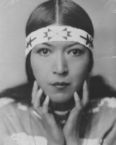Mary Alice Nelson Archambaud (Molly Spotted Elk)
 In the spotlight on stage the dark-haired dancer twirled, bells tinkling on her ankles and feathers in her hair, as the cheering began and the orchestra drumbeats rose—like thunder from far mountains echoed in chants around bright fires by lakesides, long ago. Suddenly, silence” then applause, bursting like a thundercloud, as the dark-haired dancer bowed; but her eyes seemed far, far away. So “Princess Molly Spotted Elk,” born Mary Alice Nelson on Indian Island, Maine took stages by storm across two continents in the 1920’s and 30’s. Actress, author, poet, dancer, student—and perhaps the first Maine Indian to play a major role in a silent movie—Mary Alice lived many lives and performed for both commoners and kings.
In the spotlight on stage the dark-haired dancer twirled, bells tinkling on her ankles and feathers in her hair, as the cheering began and the orchestra drumbeats rose—like thunder from far mountains echoed in chants around bright fires by lakesides, long ago. Suddenly, silence” then applause, bursting like a thundercloud, as the dark-haired dancer bowed; but her eyes seemed far, far away. So “Princess Molly Spotted Elk,” born Mary Alice Nelson on Indian Island, Maine took stages by storm across two continents in the 1920’s and 30’s. Actress, author, poet, dancer, student—and perhaps the first Maine Indian to play a major role in a silent movie—Mary Alice lived many lives and performed for both commoners and kings.
“She was a remarkable person in any light,” says the former director of the Penobscot Nation Museum, “and led, I think, one of the most amazing unknown lives of any modern American women.”
One of life’s free spirits, she paid a sad price for living. A world traveler, her story began and ended where her heart always lived, on Indian Island.
Born on Indian Island, near Old Town, on November 17, 1903, Mary Alice (in Penobscot Molly Dellis) was the first child of Philomena Solis Nelson and Horace Nelson, a future governor/chief of the Penobscot Nation. Her family had a rich heritage” Molly’s mother was one of the best basket makers of her day, her father was the first Penobscot to attend Dartmouth College, and her grandfathers, both maternal and paternal, had been leaders of their tribes. Her mother’s father was a chief of a Canadian Maliseet Tribe, he was adopted by the Maliseet Solis family but was of Penobscot 'Bear' Mitchell lineage, and her father’s father, Peter Nelson, was the vice-chief, then Lt. Governor, of the Penobscot Nation.
Molly was the eldest child and she helped raise her seven younger brothers and sisters. All were unique individuals. Her sister, Eunice, was later the first Penobscot to earn a Ph.D. Molly, most of all, took to learning traditional dances at age thirteen to help support her family, and she would ask tribal elders about the wide world. Her family always smiled at the saying “curiosity killed the cat,” which was tailor-made for Molly.
Her ambition matched her beauty, and after graduating from Old Town High School, Molly attended the University of Pennsylvania for two years, studying anthropology by day and scrubbing floors by night. Her interests were as wide as the world—archaeology, geology, ethnology, and all things Aztec, Mayan, and the Native American groups. As an eager undergraduate, she contributed to Dr. Frank Gouldsmith Speck’s study of her tribe, Penobscot Man: The Life of a Forest Tribe in Maine.
When her money gave out, undaunted, Molly turned to her beloved native dancing for a living, crisscrossing the country during Prohibition days in the vaudeville troupe of the famous Tex ("Hello, suckers!") Guinan. Stints soon followed at the Schubert Theater and the Provincetown Players, where Eugene O’Neill’s early players were produced. Performing now as "Molly Spotted Elk," she wrote her own music, made her own costumes and was a sensation everywhere-even dancing topless sometimes, her family remembers, "A happy and completely free spirit."
In 1928, her friendship with a Hollywood producer won Molly Spotted Elk the lead in a Paramount movie, "The Silent Enemy." Inspired by an actual New York Museum of Natural History expedition and filmed in northern Ontario, using an all-Indian cast and authentic Indian costumes, tools and customs, the film followed an Ojibway Indian tribe's struggle against a silent enemy-hunger-before the coming of the white man. For over a year Molly endured the Canadian cold and weather playing the central role of "Neewa," the tribal chief's daughter.
Released in 1930, "The Silent Enemy" was one of Paramount's very last silent films. Perhaps because it broke stereotypes-or was out of step with the Jazz Age-it was not a success, and "Silent Enemy" vanished into Paramount's vaults to lie forgotten for 40 years. With it went Molly Spotted Elk's career as a star.
Hollywood's loss was Europe's gain. In 1931, Molly sailed for France as the American Indian representative in the ballet corps of the International Colonial Exposition. Following her recital of native dances at Fontainbleau's Conservatory of Music, she struck out across the continent, where the Penobscot governor's daughter danced before old World royalty, including King Alphonso of Spain.
Back again briefly in America, Molly appeared as an extra in several Hollywood classics-including "Last of the Mohicans" (1936), "The Charge of the Light Brigade"(Warner Brothers, 1936), "The Good Earth" (MGM, 1937), and "Lost Horizon"(Columbia, 1936)-but her heart remained in Europe. Settling in Paris' colorful artist's colony, Molly relished the role of a vibrant American émigré, She studied at the Sorbonne, dug in dusty archives for documents about France's first contact with the Penobscots, taught ballet and caught the eye of journalist John Stephen Frederic Archambaud.
"He was just crazy about American cowboys and Indians" remembers their daughter, Jean. "He begged for an opportunity to interview her. Well, they met and they married."
Jean Archambaud was the only child of their "very spiritual and sadly short marriage. When World War II burst over Europe, Archambaud, a political journalist for Le Paris Soir, was Red Cross Relief Director near Bordeaux, and an outspoken anti-Nazi. After France fell to the Nazis in 1940, he vanished, and Molly and her 6-year-old daughter fled on foot over the Pyrenees Mountains into Portugal.
"We walked, we ran, we rode ambulances," Jean recalls. "A newsman picked us up once, and my mother always claimed it was Howard K. Smith. Adventure always followed her even in adversity."
On their coming to the United States, their ship cabin was ransacked and searched. Even after the war ended Molly never could find any final word about her husband's fate.
Sorrow followed her home to Indian Island, where she arrived in July 1940, but then went to New York City and continued performing, returning to Indian Island for good in the early 1950's. Molly's only grandson John, named in memory of her husband, inherited much of her adventurous spirit. In 1973, he bravely carried medicine between the armed camps when the FBI and the American Indian Movement, (AIM) squared off during the Indian occupation of Wounded Knee, South Dakota, the site of the 1891 United State Army massacre that ended the Plains Indian Wars. In 1974, he returned to Lincoln, Nebraska, to serve as a witness in the Federal trials that followed and was killed under mysterious circumstances. His death, too, was never resolved.
"He lived with Molly, and she loved him dearly," recalls Jean. "To this day, nothing adds up right. An artist to the end, in her old age Molly crafted Indian dolls in traditional dress, some of which are now in the Smithsonian. She wrote constantly-children's stories based on Penobscot legends, a translation of Penobscot into English and French-and saved reams of diaries, notes, and a lifetime of letters. In recent years a copy of "The Silent Enemy," was rescued from deterioration in Paramount's vaults and has enjoyed a revival in anthropology classes at Vassar and other American colleges Penobscot youth may now see a copy of the film at the Penobscot Nation Museum on Indian Island. "I was so caught up in the experiences of seeing my mother--so young again," her daughter Jean smiles. She sought learning all her life, and now it's a teaching tool, I think she'd like that." Molly Spotted Elk, the dark-eyed dancer who once delighted audiences around the world, died on Indian Island February 21, 1977, at the age of 73. In 1986, Molly became a charter member of the Native American Hall of Honor in Page, Arizona, there joining Louis Sockalexis and Joseph Attean to present the proud Penobscot Nation. "Molly Spotted Elk's life made a full circle," reads her charter certificate. "It was trail of tears." Molly's life has been the subject of numerous interviews in Maine newspapers. But Spotted Elk's story has now been captured in full in Bunny McBride's Molly Spotted Elk: A Penobscot in Paris (University of Oklahoma Press, 1995).A journalist and Columbia University-trained anthropologist, McBride recreates the details of Spotted Elk's life in a rich and inviting prose born of Spotted Elk's own diaries.
The Saturday Evening Post lauded Spotted Elk and "The Silent Enemy" as deserving of a Pulitzer Prize as "the best American dramatic creation for the year 1930" -- and in an ironic fulfillment of that commendation, McBride's book has been nominated for the Pulitzer Prize for biography. It is worthy of that and more. Accessible to the young reader, detailed enough for the scholar of Indian history, "Molly Spotted Elk" is an enjoyable book to read.
Today Molly Spotted Elks writings exist in a book published by the Maine Folklife Center. The book, by author Molly Spotted Elk, is titled: Katahdin: Wigwam’s Tales of the Abnaki Tribe, is part of the Northeast Folklore Series.
